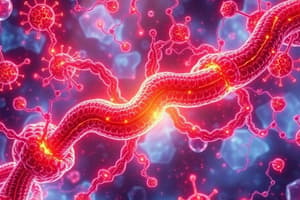Podcast
Questions and Answers
What is the primary function of citrate synthase in the tricarboxylic acid cycle?
What is the primary function of citrate synthase in the tricarboxylic acid cycle?
- To convert citrate into isocitrate
- To regenerate oxaloacetate from malate
- To synthesize citrate from oxaloacetate and acetyl-CoA (correct)
- To produce ATP from ADP and Pi
Which substrate is directly converted into isocitrate by citrate synthase?
Which substrate is directly converted into isocitrate by citrate synthase?
- Malate
- Pyruvate
- Citrate
- Oxaloacetate (correct)
Which molecule acts as both a product and a substrate in the reactions occurring in the tricarboxylic acid cycle?
Which molecule acts as both a product and a substrate in the reactions occurring in the tricarboxylic acid cycle?
- NADH
- Acetyl-CoA
- Malate (correct)
- Citrate
What role does NADH play in the tricarboxylic acid cycle?
What role does NADH play in the tricarboxylic acid cycle?
Which enzyme catalyzes the conversion of malate back to oxaloacetate?
Which enzyme catalyzes the conversion of malate back to oxaloacetate?
In the tricarboxylic acid cycle, which molecule is generated alongside ATP during the oxidation of isocitrate?
In the tricarboxylic acid cycle, which molecule is generated alongside ATP during the oxidation of isocitrate?
Which of these is NOT a product of the tricarboxylic acid cycle?
Which of these is NOT a product of the tricarboxylic acid cycle?
What effect does ATP have on the activity of the enzymes in the tricarboxylic acid cycle?
What effect does ATP have on the activity of the enzymes in the tricarboxylic acid cycle?
What is the main characteristic of the inner mitochondrial membrane regarding permeability?
What is the main characteristic of the inner mitochondrial membrane regarding permeability?
Which of the following metabolites can easily pass through the outer mitochondrial membrane?
Which of the following metabolites can easily pass through the outer mitochondrial membrane?
What role do specific membrane transport systems serve in the mitochondria?
What role do specific membrane transport systems serve in the mitochondria?
Which of the following statements about the composition of the outer mitochondrial membrane is correct?
Which of the following statements about the composition of the outer mitochondrial membrane is correct?
What happens to NADH in relation to the inner mitochondrial membrane?
What happens to NADH in relation to the inner mitochondrial membrane?
Which of the following is NOT a characteristic of the inner mitochondrial membrane?
Which of the following is NOT a characteristic of the inner mitochondrial membrane?
What is the function of ATPase in the mitochondria?
What is the function of ATPase in the mitochondria?
Which of the following components contributes to creating a proton gradient in the mitochondria?
Which of the following components contributes to creating a proton gradient in the mitochondria?
What is the primary function of the glycerol-P shuttle?
What is the primary function of the glycerol-P shuttle?
Which molecule is formed from glycolysis in the cytosol that directly impacts the glycerol-P shuttle?
Which molecule is formed from glycolysis in the cytosol that directly impacts the glycerol-P shuttle?
In the context of mitochondrial transport systems, what does the term 'reducing equivalents' refer to?
In the context of mitochondrial transport systems, what does the term 'reducing equivalents' refer to?
What role does NAD+ play in the glycerol-P shuttle mechanism?
What role does NAD+ play in the glycerol-P shuttle mechanism?
Which of the following processes is NOT associated with the mitochondrial transport systems?
Which of the following processes is NOT associated with the mitochondrial transport systems?
Which shuttle system transfers reducing equivalents specifically from cytosol to mitochondria?
Which shuttle system transfers reducing equivalents specifically from cytosol to mitochondria?
Which shuttle is more commonly involved in transporting NADH across the mitochondrial membrane?
Which shuttle is more commonly involved in transporting NADH across the mitochondrial membrane?
What is one consequence of impaired function of the glycerol-P shuttle?
What is one consequence of impaired function of the glycerol-P shuttle?
What is the main function of the glycerol-P shuttle?
What is the main function of the glycerol-P shuttle?
What occurs to NADH in the glycerol-P shuttle process?
What occurs to NADH in the glycerol-P shuttle process?
Which compound is directly formed from dihydroxyacetone phosphate in the shuttle system?
Which compound is directly formed from dihydroxyacetone phosphate in the shuttle system?
How many ATP are produced by the glycerol-P shuttle?
How many ATP are produced by the glycerol-P shuttle?
What is the initial substrate for the production of acetyl-CoA in the context of the shuttle?
What is the initial substrate for the production of acetyl-CoA in the context of the shuttle?
Which enzyme is responsible for the conversion of fumarate in the shuttle process?
Which enzyme is responsible for the conversion of fumarate in the shuttle process?
What type of shuttle is the malate-aspartate shuttle categorized as?
What type of shuttle is the malate-aspartate shuttle categorized as?
Which of the following statements is true regarding the malate-aspartate shuttle?
Which of the following statements is true regarding the malate-aspartate shuttle?
What role does acetyl-CoA play in metabolism?
What role does acetyl-CoA play in metabolism?
Which stage of metabolism involves the transport of reducing equivalents?
Which stage of metabolism involves the transport of reducing equivalents?
What does the regulation of the Pyruvate Dehydrogenase (PDH) complex primarily involve?
What does the regulation of the Pyruvate Dehydrogenase (PDH) complex primarily involve?
Which factor impairs energy conservation in the respiratory chain?
Which factor impairs energy conservation in the respiratory chain?
What is the significance of reversible phosphorylation in enzyme regulation?
What is the significance of reversible phosphorylation in enzyme regulation?
What clinical condition is associated with Pyruvate Dehydrogenase deficiency?
What clinical condition is associated with Pyruvate Dehydrogenase deficiency?
Why are mitochondrial transport systems important?
Why are mitochondrial transport systems important?
Which process is involved in oxidative phosphorylation?
Which process is involved in oxidative phosphorylation?
Flashcards are hidden until you start studying
Study Notes
Bioenergetics Overview
- Bioenergetics encompasses the metabolic processes that generate energy within cells.
- Metabolism occurs in three stages: glycolysis, the tricarboxylic acid (TCA) cycle, and oxidative phosphorylation.
Pyruvate Dehydrogenase Complex
- Catalyzes the conversion of pyruvate to acetyl-CoA.
- Key roles in linking glycolysis with the TCA cycle, critical for energy production.
- Regulation involves feedback from its products, ensuring balance in energy metabolism.
Tricarboxylic Acid Cycle (TCA)
- Also known as the Krebs cycle or citric acid cycle.
- Functions in energy production and the synthesis of macromolecules.
- Involves key reactions producing NADH and FADH₂, which feed into the respiratory chain.
- Links to inflammatory responses and clinical conditions such as PDH deficiency and Beri-beri.
Mitochondrial Respiratory Chain
- Comprises complexes that transfer electrons from NADH and FADH₂ to oxygen.
- Involves electron transfer mechanisms, including inhibition (e.g., cyanide toxicity).
- The direction and entry points of electron transfer are crucial for efficient ATP generation.
Oxidative Phosphorylation
- Mechanism relies on chemiosmotic coupling to synthesize ATP.
- Inhibitors and uncouplers can disrupt this energy conservation process.
- Impaired oxidative phosphorylation linked to hypoxic injury and metabolic disorders.
Mitochondrial Transport Systems
- Outer mitochondrial membrane allows free passage of many solutes, while the inner membrane is selectively permeable.
- Specific transporters manage the exchange of metabolites between the mitochondrial matrix and cytosol, ensuring metabolic efficiency.
Transport of Reducing Equivalents
- Glycerol-P shuttle: translocates reducing equivalents (NADH from glycolysis) into mitochondria.
- Malate-aspartate shuttle: another system to transport reducing equivalents, essential for energetic metabolism.
Key Functions and Implications
- Understanding reversible phosphorylation is pivotal for regulating enzyme activity.
- Acetyl-CoA serves as a crucial intersection of metabolic pathways.
- Energy yield varies based on the entry point of reducing equivalents into the respiratory chain.
- Mitochondrial transport systems are integral for maintaining metabolic balance.
Clinical Correlations
- Disorders like PDH deficiency impact energy metabolism and correlate with various health conditions.
- Impacts of factors such as hypoxia highlight the importance of bioenergetics in cellular health.
Studying That Suits You
Use AI to generate personalized quizzes and flashcards to suit your learning preferences.





